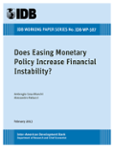Does Easing Monetary Policy Increase Financial Instability?
Date
Feb 2013
This paper develops a model featuring both a macroeconomic and a financial stability objective that speaks to the interaction between monetary and macroprudential policies. First, we find that interest rate rigidities in a monopolistic banking system have an asymmetric impact on financial stability: they lead to greater financial instability in response to contractionary shocks, while they act as an automatic financial stabilizer in response to expansionary shocks. Second, we find that when the policy interest rate is the only instrument, a monetary authority subject to the same constraints as private agents cannot always achieve a (constrained) efficient allocation and faces a trade-off between macroeconomic and financial stability in response to contractionary shocks. This has important implications for the role played by U. S. monetary policy in the run-up to the global financial crisis: the model suggests that the weak link in the U. S. policy framework was not the monetary policy stance after 2002, but rather the absence of an effective second policy pillar aimed at preserving financial stability.



